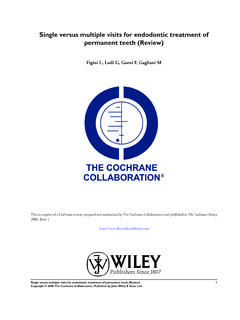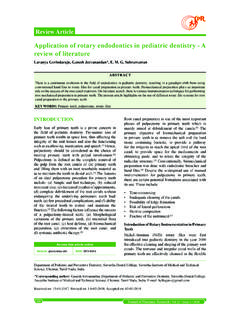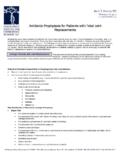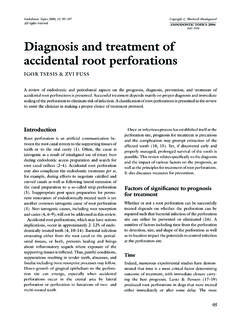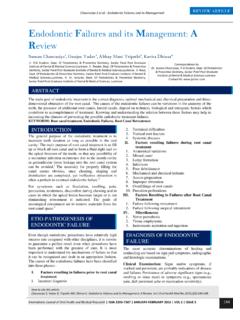Transcription of The WaveOne reciprocating endodontic system
1 Titanium file fracture is around 5%, with 70% of thefractures caused by flexural fatigue fracture and theremaining 30% by torsional is a new nickeltitanium alloy that is prepared by a special thermal processthat is claimed to increase flexibility and resistance to ,5It is reported that instruments made from M-Wirewith a Profile instrument (Dentsply/Maillefer) design exhibitnearly 400% more resistance to cyclic fatique than superelastic wire instruments of the same mentioned, the instruments are single-use and thisprovides the clinician with the following advantages.
2 Elimination of repeated usage of instruments can reducethe instrument fatigue with a general decrease ininstrument Elimination of possible cross contamination that isassociated by the inability to adequately clean and sterilizepreviously used ,7 No need for disinfecting, cleaning, sterilizing andorganizing because the instruments are disposed aftereach WaveOne reciprocatingendodontic systemPeet van der Vyver1 ClinicalThe WaveOne NiTi File system (Dentsply/Maillefer) was firstintroduced to the dental market in 2010.
3 It is a pre-packaged, pre-sterilised, single-use system that is indicatedto shape root canal systems to a continuously ,2 In the majority of cases a single-file can be used tocomplete root canal preparation in single or multiple rootcanal systems. Instead of a rotary motion, the files work in areverse balanced force cutting motion1and is driven by apre-programmed motor (X-Smart Plus motor fitted with 6:1reducing hand piece)(Dentsply/Maillefer) that is capable ofmoving the files in a back and forth reciprocating counter clockwise (CCW) movement of 150 degrees iscapable of advancing the instrument apically by engagingand cutting the dentine on the root canal wall, followed bya 30 degrees clockwise (CW) movement ensuring that theinstrument disengages before excessive torsional stress istransferred onto the metal alloy and before the instrumentcan bind (taper lock) into the root canal.
4 Three continuousreciprocating cycles will complete one complete reverserotation and this will allow the instrument to advanceapically into the root addition, the WaveOne instruments are alsomanufactured using M-Wire technology to improve thefracture resistance of the instruments. Paraschos, Gordonand Messer (2004) reported that the incidence of nickel6 INTERNATIONAL DENTISTRY AFRICAN EDITION VOL. 3, NO. 51 Professor Peet van der Vyver, BChD, Extraordinary Professor, Schoolof Dentistry, University of Pretoria, South practice, Sandton, South AfricaEmail: 1: WaveOne instruments: Small 21/06 (yellow ring); Primary25/08 (red ring); Large 40/08 (black ring).
5 Guideline 2: Negotiate canals to patency and create areproducible glide path The author prefers to negotiate each root canal with a size08 or 10 K-File until apical patency is established (Figure 3).According to Ruddle (2012) one of the greatest challengesof endodontic treatment is the ability to find, follow andpredictably secure any given canal to its is the ability to pass small K-Files -1mm passivelythrough the apical constriction, beyond the minor diameterwithout widening After working length determination and radiographicconfirmation (Figure 4), a reproducible glide path should beestablished.
6 According to West (2008) a glide path is asmooth passage that extends from canal orifice in the pulpchamber to its opening at the root authorsrecommend that the glide path should be the same size as,or ideally a size bigger that the first rotary instrument thatwill be introduced into the root canal system . 9,14,15 It is recommended to use stainless steel K-files in avertical in and out motion with an amplitude of 1mm andgradually increasing the amplitude as the dentine wall wearsaway and the file advances recommends aminimum of a super loose size 10 K-file as the ,14To confirm that a reproducible glide pathis present, a size 10 file is taken to full working length.
7 Thefile is then withdrawn 1mm and should be able to slide backto working length by using light finger pressure. Thereafter,Clinical INTERNATIONAL DENTISTRY AFRICAN EDITION VOL. 3, NO. 57 The WaveOne single-file reciprocating system (Figure 1) isavailable in three different file sizes in lengths of 21, 25, and31 Small File The tip of the file is ISO 21 with acontinuous fixed taper of 6%. Primary File The tip of the file is ISO 25 andhas a continuously decreasing taper from its tip to its shaft( , , , ) Large File The tip of the file is ISO 40 and hasa continuously decreasing taper from the tip to the shaft( , , , ) The three files are also characterized by different crosssectional designs over the entire length of the working partof the instruments.
8 In the tip region the cross sectionpresents radial lands while in the middle part and near theshaft the cross sectional diameter changes from a modifiedtriangular convex cross section with radial lands to a neutralrake angle with a triangular convex (reciprocation) versus continuous rotation ofnickel titanium instruments has the following advantages: Binding of the instruments into the root canal dentinewalls will be reduced with a reduction in torsional By reducing the number of cycles within the root canalduring preparation the flexural stress on the instrumentwill be Decreased risk of instrument ,9 Clinical guidelines for the use of WaveOneinstrumentsGuideline 1.
9 Create straight line access It is important to prepare an adequate access cavity that willensure straight-line access into each root canal system afterremoval of all the pulp chamber contents. Ultrasonicinstruments eg. Start-X ultrasonic instruments(Dentsply/Maillefer) are very useful instruments to remove anypulp calcification and to refine the access cavity walls toimprove straight-line access. Radicular access can beimproved by using an SX instrument form the ProTaperUniversal system (Dentsply/Maillefer) to remove any internaldentine triangles (Figure 2).
10 The recommended method ofuse is to introduce the file into the coronal portion of the rootcanal ensuring that the file is able to rotate freely. Restrictivedentine is then removed using a backstroke, outwardsbrushing motion. This step will also relocate the canal orificesmore mesially (away from furcal danger in the case of lowermolars) and pre-flare the coronal third of the root 2: (a) Internal dentine triangle (arrow) prevents straight lineaccess into mesio-buccal and mesio-lingual root canals.
